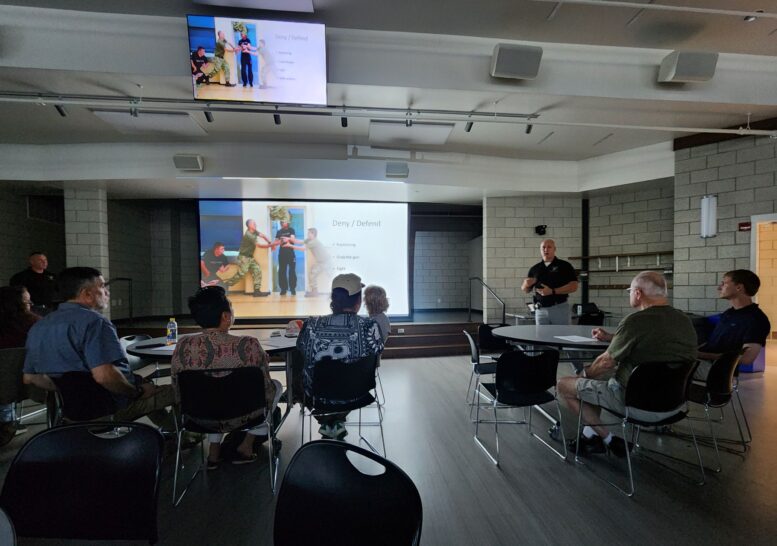By JAN McLAUGHLIN
BG Independent News
The video showed harrowing scenes of concert-goers huddled together in fear, trying to avoid the next round of shots from the shooter in Las Vegas in 2017. When it was over, the shooter had killed 58 people and wounded more than 500.
It was the deadliest mass shooting in U.S. history by a single gunman.
The well-documented filming of the attack has given law enforcement tools to train the public on how to protect themselves from mass shooters.
“Unfortunately, in 2024, this is the world we live in,” said Det. Sgt. Ryan Richards with the Wood County Sheriff’s Office.
Richards and other members of the Wood County Sheriff’s Office Special Response (SWAT) team – Bowling Green Police Sgt. Caleb Kusmierek and Perrysburg Township Police Sgt. Dustin Glass – held a class last week in Bowling Green for people wanting to learn tips on protecting themselves.
“Stop the Bleed” training was also offered by local paramedics on how to identify life-threatening bleeding, how to control it, and how to apply direct pressure techniques and tourniquets, using whatever material is available.
There have been more than 385 mass shootings across the U.S. so far this year, according to the Gun Violence Archive, which defines a mass shooting as an incident in which four or more people are injured or killed. For each of the last four years there have been more than 600 mass shootings. And that doesn’t take into account all the shootings in which fewer than four people were killed.
Mass shooting history in the U.S. shows that no place is off limits. Over recent years, mass shooting attacks have occurred in homes, schools, churches, grocery stores, concert venues, and workplaces.
Just this month, mass shootings have been recorded in a Georgia school, an Illinois train, and outside a club in Alabama.
So at a time when mass shootings are becoming commonplace, the SRT members want to give local residents tips on how to plan ahead, how to recognize potential threats, and how to respond if an attack occurs.
Officers went through scenarios of several mass shootings – Dayton outside a bar, killing nine; El Paso inside a Walmart, killing 22; Aurora, Illinois, in a warehouse, killing five; Orlando, Florida, in a nightclub, killing 49; and Virginia Tech, in classrooms, killing 32.
The officers stressed that anytime people walk into a setting, they should be looking for other ways out – doors, windows – if necessary. Find an exit that isn’t a deadend, they emphasized. Many victims at the Pulse nightclub in Orlando fled to the restrooms, only to be gunned down in a room with no way out.
“Be thinking, if something happens, what are my options,” Richards said.
If at all possible during an active shooter event, people should leave belongings behind and try to escape.
“Run and keep going,” Richards said. “We don’t want you to be sitting ducks. It’s hard to hit a moving target.”
If running isn’t an option, then people were advised to hide and:
- Block entry by barricading or locking doors.
- Hide out of the shooter’s view.
- Silence cell phones.
And if hiding isn’t an option, look around for potential weapons (like a fire extinguisher) and fight:
- Commit to decisive and aggressive action.
- Goal is to incapacitate the shooter.
- Fight until the threat is neutralized.
The Special Response Team members also suggested that people be aware of how their body reacts to stress. Practice calm breathing – and turn fear for oneself into anger at the shooter.
Though some people freeze up in the face of a shooter, the officers warned about playing dead. Video was played of a survivor of the Virginia Tech shootings, who was shot three times as she played dead and the shooter continued returning to unbarricaded classrooms and went row by row firing into people.
“The last thing we want anyone to do is play dead,” Richards said. “Fight for your life. We don’t want you to be an easy target.”
“We don’t want you to just hide and hope,” Kusmierek said.
Today’s mass shooters often wear body armor and use guns that shoot rounds in rapid succession. That can lead to more deaths and injuries.
While there is “no set demographic” for mass shooters, the officers did list some potential warning signs including:
- Increasingly erratic, unsafe or aggressive behaviors.
- Hostile feelings of injustice or perceived wrongdoing.
- Drug and alcohol abuse.
- Marginalization or distancing from friends and colleagues.
- Changes in performance at work.
- Sudden and dramatic changes in home life or in personality.
- Financial difficulties.
- Pending civil or criminal litigation.
- Observable grievances with threats and plans of retribution.
Be aware of suspicious appearance:
- Wearing clothing that is inappropriate for the weather or location.
- Bulges or unusual shapes under clothing that could indicate a concealed weapon.
- Wearing clothing that is commonly associated with criminal activity.
- Unusual or excessive sweating.
- Unkempt or disheveled appearance.
When possible, provide law enforcement or 911 operators with:
- Location of shooter.
- Number of shooters.
- Physical description of shooters.
- Number and types of weapons.
- Number of potential victims.
When police arrive:
- Follow commands.
- Show your palms.
- Do not move until told.
- Remain calm.
- Put down any items.

